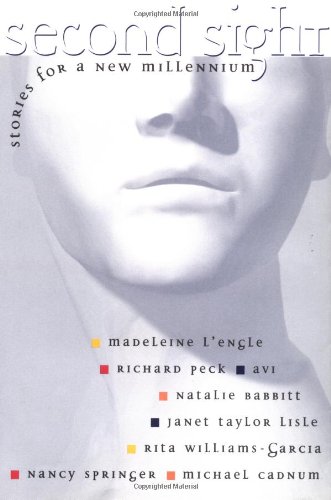Synopsis
Provides eight stories by various teenage authors who make their prediction as to what the the future in the new millennium will hold for the world in which we live.
Reviews
Madeleine L'Engle, Richard Peck and other favorite authors transit eight characters into the 21st century. These stories, mostly slices of realism with a hint of the supernatural, introduce universal teens with familiar conflicts. Not so coincidentally, most protagonists experience epiphanies on or around New Year's Eve. In Janet Taylor Lisle's tale, shortly before a girl rings in the year 2000 in Mexico with her family, she has a run-in with a teenage gang amongst Mayan ruins, which turns into a transformative experience. On the same evening, miles away, in Nancy Springer's selection, Mike plans to spend an uneventful night as disc jockey for a local radio stationAuntil spectators in Times Square claim to have seen Jesus in the sky, and an accident seriously injures both a co-worker and his father. While the millennium theme lurks perhaps too conspicuously in the shadows of many stories, at least two authors manage to gracefully broaden it. Natalie Babbitt's timeless fantasy shows how a father, obsessed with glimpsing tomorrow, goes to absurd lengths to find out what the future has in store. Rita Williams-Garcia's lyrical tale, with its folkloric quality, mourns the loss of age-old traditions as modern concerns obscure the importance of family roots ("Gone is the simple need to shake off the world and be among the familiar"). Ages 10-up. (Oct.)
Copyright 1999 Reed Business Information, Inc.
An uneven collection of stories about the new millennium from well-known YA authors. Avi's ``Oswin's Millennium'' is a powerful depiction of the life of an ill-treated slave boy who is convinced by one of the brothers that the world is about to end. Among the high points: Nancy Springer pens a surprisingly moving piece about a college disc jockey on New Year's Eve, 1999, who starts hearing from listeners who are terrified. Natalie Babbitt's ``Tomorrow,'' about a man who goes up in a balloon trying to see what the next day will be like, reads like a chapter out of Bradbury's ``Dandelion Wine.'' Richard Peck's ``Three Century Woman,'' features one of his hilariously devilish old women; she's not as senile as she pretends, and gets the better of some pushy reporters. At the other end of the collection, there is a bizarre muddle called ``Clay'' from Rita Williams-Garcia, about women who practice a form of magic that involves a clay pot containing their children's umbilical cords; and an Austin story from Madeleine L`Engle that recycles the pun that the millennium bug is an actual insect. There are also pieces by Janet Taylor Lisle and Michael Cadnum; the whole comprises a mixed bag, but the good outweighs the bad. (Short stories. 10-14) -- Copyright ©1999, Kirkus Associates, LP. All rights reserved.
From Avi's ironic "Oswin's Millennium," where the millennium in question is the last one, to Richard Peck's funny yet poignant, "The Three Century Woman" set in January 2001, these eight original short stories vary greatly in tone, perspective, and setting. As the only unifying theme, the millennium is a major factor in most selections but a minor one in a few. Other authors include Natalie Babbitt, Michael Cadnum, Madeleine L'Engle, Janet Taylor Lisle, Nancy Springer, and Rita Williams-Garcia. As with most collections, some stories are more memorable than others, but as a group these will stimulate thought and discussion about the millennium and serve as a springboard into creative writing projects. Linda Perkins
Grade 6-9-A collection of short stories by eight top young adult authors. The selections are largely compelling and reflect all of the uncertainty, dread, and anticipation that surround this momentous milestone. The book opens with "Oswin's Millennium," Avi's haunting tale of an abused stable boy set in the first millennium, and closes with "The Three-Century Woman," Richard Peck's hilarious story of an elderly woman who beats a TV interviewer at his own game. In between, stories by Janet Taylor Lisle, Rita Williams-Garcia, Nancy Springer, and Michael Cadnum examine people's responses to the millennium, while Madeleine L'Engle gives a brief glimpse of the Austin family as it reacts to Rob's belief that a real millennium bug (an enormous beetle) might exist. However, it is Natalie Babbitt who defines the most basic question about the millennium in her story "Tomorrow." Mr. Rummage is convinced that people want to know what will happen tomorrow and he devises numerous ways, including a balloon trip, to try and find out. But it is an old man in the park who gets to the heart of the matter when he says, "Who cares what kind of a day it's going to be? What matters is, if there's even going to be a day." And when the dawn colors streak the sky, both the old man and Mr. Rummage know the truth, and so do readers.
Barbara Scotto, Michael Driscoll School, Brookline, MA
Copyright 1999 Reed Business Information, Inc.
"About this title" may belong to another edition of this title.
